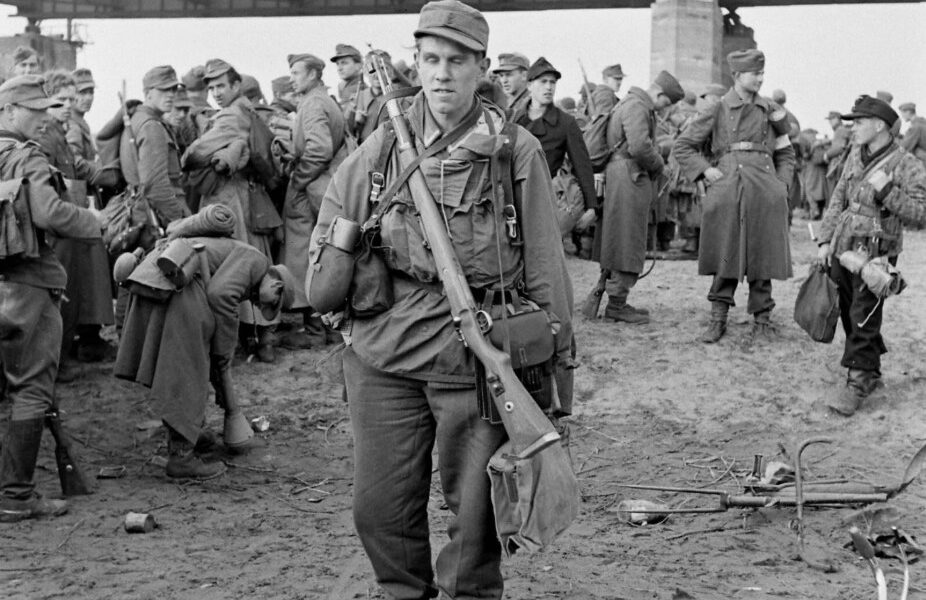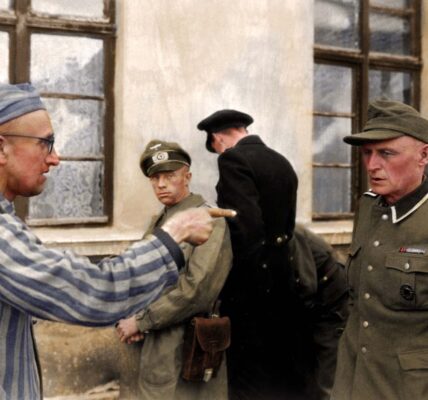
World War II – German soldiers prepare for surrender, Germany 1945.

Fallen German soldiers are buried under U.S. supervision by German prisoners of war in Manche, Normandy – July 1944. LIFE Magazine Archives – Photographer: Ralph Morse – WWP-PD

In the photo: Kriegsmarine sailors next to a 20 mm MG-FF cannon at an observation post.

In the photo: German soldiers march to the Eastern Front (1942).
It can be seen that they are armed with the Karabiner 98k.

In the photo: A Panzer III on a test site (May 1937).

In the photo: Luftwaffe soldiers next to an 88 mm Flak anti-aircraft gun.
The enormous 88 mm projectiles can be seen.

In the photo: German soldiers next to a 50 mm PaK 38 anti-tank gun.

In the photo: German soldiers next to an MG-34 machine gun during a training exercise.

In the photo: German soldiers, exhausted from the intense fighting on the Eastern Front, wait for new orders to launch Operation Spring Awakening (1945).
It can be seen that the soldier in the foreground is armed with an MG-42 machine gun.

In the photo: A German soldier reports the number of received wooden hand grenades of the M-24 model (1943).

In the photo: A German soldier next to a 5 cm Granatwerfer 36 on the outskirts of Leningrad (1943).

In the photo: A German soldier digs out a Zundapp KS-600 motorcycle with sidecar stuck in the mud (1943).

In the photo: German soldier Fritz Reidel returns to his wife and three children on May 21, 1945.
According to German statistics, most prisoners of war were released faster than Allied soldiers: Of the 2 million prisoners held by the Soviets, 900,000 were released in 1946, 300,000 in 1947 and 1948, and another 400,000 in 1949. Thus, 45% returned within one year, 60% within two years, and 75% within three years. Only 5% remained in captivity until the 1950s.

In the photo: A German soldier in the pose “presenting the rifle” (1939).
It can be seen that he is armed with a Karabiner 98k.

In the photo: German soldiers next to a 15 cm Nebelwerfer 41 multiple rocket launcher.
This powerful weapon was primarily used to support infantry and was known for its characteristic howling sound when fired, which often caused panic among opponents.

In the photo: German soldiers with an MG-34 machine gun in firing position.
This reliable weapon was used both by infantry and as on-board weapon in vehicles and was considered one of the most advanced machine guns of its time.

In the photo: German soldiers cross a bridge in Polish territory that was bombed by Polish troops to stop the German advance (September 8, 1939).
Such scenes were part of the early phase of World War II, when the Wehrmacht implemented its Blitzkrieg strategy, which relied on speed and surprise, and occupied Poland within a few weeks.

Luftwaffe soldiers watch a local girl in traditional clothing hanging laundry during the summer of 1940.

A fully camouflaged German soldier with a drum-loading MG 34 on the Eastern Front.

A German paratrooper eats during a lull in the fighting at the Battle of Ortona in Italy (December 22, 1943).

In the photo: Field Marshal Walter Model with his staff officers somewhere on the Eastern Front.

A German grenade launcher and his comrades are carrying a wounded man on an improvised stretcher, behind them a Panzer IV.

A German soldier jumps over a trench with an MG34 in his hand.

A German soldier jumps over a trench with an MG34 in his hand.

German soldiers advance to the front line.


Norwegian fighter pilot Erik Haaborn shows the squadron insignia of his squadron, which flew the Typhoon Mk1b.


Men of Easy Company, 506th Parachute Infantry Regiment, 101st Airborne Division, relax at the Berghof, the so-called “Eagle’s Nest.”

A German prisoner of war, captured in Stalingrad, is escorted by a Soviet soldier.

A German paratrooper eats during a lull in the fighting at the Battle of Ortona in Italy (December 22, 1943).

A fully camouflaged German soldier with a drum-loading MG 34 on the Eastern Front.

In the photo: Field Marshal Walter Model with his staff officers somewhere on the Eastern Front.

A German grenade launcher and his comrades are carrying a wounded man on an improvised stretcher, behind them a Panzer IV.

Luftwaffe soldiers watch a local girl in traditional clothing hanging laundry during the summer of 1940.

A German soldier jumps over a trench with an MG34 in his hand.

A German soldier jumps over a trench with an MG34 in his hand.

German soldiers advance to the front line.


Norwegian fighter pilot Erik Haaborn shows the squadron insignia of his squadron, which flew the Typhoon Mk1b.


Men of Easy Company, 506th Parachute Infantry Regiment, 101st Airborne Division, relax at the Berghof, the so-called “Eagle’s Nest.”

A German prisoner of war, captured in Stalingrad, is escorted by a Soviet soldier.

The photo shows the fuselage of a Heinkel He-111 bomber flying through the village of Loye in France (1939).

The photo shows German soldiers on a BMW R12 motorcycle .

Cheng of the League of German Girls (BDM) presented flowers to officers of the Condor Legion in Hamburg on May 31, 1939 .

In the photo, German soldiers are ready to open fire with an MG-34 machine gun mounted on a BMW R-75 motorcycle .

Soldiers of the $$ buy ice cream in the warm and sunny center of Amsterdam (June 1940).

The photo shows a German soldier on a BMW R-75 motorcycle.

The photo shows German paratroopers on a BMW R-75 motorcycle.

In the photo, German paratroopers pose with a small baby eagle owl , presumably the mascot of their unit.

The photo shows Gerardus Mooyman , the first foreign volunteer to be awarded the Knight’s Cross of the Iron Cross – this is also shown by the child pointing at the medal.
He received the award for the destruction of 13 enemy tanks at Krasny Bor . Mooyman survived the war, was arrested several times, and escaped before being sentenced to six years in prison in 1946 and released in 1949.
Later, he led a quiet life as a businessman, husband, and father. In an interview in the 1960s, he distanced himself from National Socialism and stated that he had given his Knight’s Cross to a collector.

In the photo, Colonel General Ernst Busch inspects an anti-aircraft gun position .

Two German soldiers resting in front of the Palais des Beaux-Arts in Lille (early June 1940).

Stalingrad is hell on earth, it is Verdun, the red Verdun, with new weapons.
We attack every day. If we advance 20 meters in the morning, the Russians drive us back by the afternoon.
• Letter from Corporal Walter Oppermann.

The photo shows a German machine gunner with an MG-34 machine gun on the outskirts of Stalingrad (December 22, 1942).
Army Group Don , under the command of General Erich von Manstein , launched an offensive to liberate the encircled 6th Army at Stalingrad. Despite its incomplete strength, the army group showed remarkable fighting spirit and broke through the Soviet siege network on December 20 , advancing 62 kilometers from Stalingrad.
The 4th Panzer Army under General Hermann Hoth managed to get within 35 kilometers of the city, but further advance was hardly possible.
Manstein urged General Friedrich Paulus , commander of the 6th Army, to attempt a breakout from Stalingrad. Paulus, however, hesitated, declaring that he could not retreat without a direct order from Hitler . This indecision led to the failure of Army Group Don’s rescue efforts.
In the end, Army Group Don had no choice but to retreat 100 kilometers .

The photo shows Corporal Gerhard Paul Kurt Stendke together with his wife Martha Pauline Auguste Stendke and their little daughter in a field hospital (February 28, 1943).

In the photo, Joseph Goebbels awards the Iron Cross to 16-year-old Willi Hübner in Luban, Silesia on March 9, 1945 .
Willi served as a messenger during the battle to recapture the region from the Soviet Army . He survived the war and later became a politician in the former GDR .










